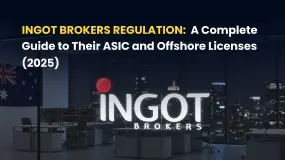简体中文
繁體中文
English
Pусский
日本語
ภาษาไทย
Tiếng Việt
Bahasa Indonesia
Español
हिन्दी
Filippiiniläinen
Français
Deutsch
Português
Türkçe
한국어
العربية
WIKIFX REPORT: What did we learn from Q3 earnings?
Abstract:The third quarter or Q3 earnings season in the US is now drawing to a close, so what takeaways are there for traders from the results marathon?
The third quarter or Q3 earnings season in the US is now drawing to a close, so what takeaways are there for traders from the results marathon?
The bulk of Q3 earnings was posted throughout October into early November and so a good place to start our investigation is equity index performance during that period.
Looking at the chart below there is an obvious divergence between the three main US equity indices.
The Nasdaq 100 index, drawn in orange, fell by as much as -5.27% during October while the S&P 500, the blue line, ranged between a -2.32% loss and a +7.0% gain in that time frame.
However, the best performer by far was the Dow. The narrowest and most established of the three indices, rallied by +14.0% last month, halving its year-to-date losses in the process.
In fact, October was the best month for the Dow since 1976.

Earnings themselves werent necessarily that great but they were a lot better than many analysts were expecting.
As of November 4th, 85% of S&P 500 companies had reported Q3 numbers and 70% of those posted a positive earnings surprise whilst 71% of the companies, reported a beat on revenues. That level of revenue beats is above the 5 -year average of 69.0%.
Earnings growth rates were low but positive
In aggregate S&P 500 companies showed earnings growth of +2.20% according to data from Factset. In terms of valuation, the 12-month forward PE ratio for the S&P 500 is 16.10 times earnings.
That figure is below both the five and ten-year averages for the index, which are found at 18.5- and 17.10-times earnings respectively. So, the S&P 500 stocks are not expensive versus history on this measure.

However, Wall Street analysts dont believe that earnings will grow at all, in the fourth quarter of 2022. So, one might argue that US stocks are cheap for a reason.
And as we can see in the chart above the analysts are now predicting that earnings in the index will shrink by an average of -1.0% in Q4. If thats the case, it would be the first quarter of negative earnings growth since Q3 2020.
Foot on the gas
Its not a bleak picture in every sector of course and the S&P 500 Energy stocks had another bumper quarter over the last the Energy sector has rallied by 11.742% and is up more than 66% year to date.
The best-performing large-cap stock in the US during 2022 is an energy stock.
Occidental Petroleum (OXY) is up 149.50% year to date, whilst oil services group Baker Hughes (BKH) has seen its stock price bounce by almost 33.0% in the last month.
Individual performance
Twenty-five stocks within the S&P 500 made gains of +26.0% or more during October.
Eleven of these stocks were in energy or energy-related industries, but others came from medicine and healthcare, from travel and leisure, and two were old economy names from the industrial sector. Technology was conspicuous by its absence, however.
Overall, there was very little to link these stocks together, other than their performance during October and the affiliation of a large proportion of the names to the energy sector.
However, they did share one common trait and that was that pre, and in many cases, post-earnings momentum.
That momentum was captured and highlighted by the stocks interaction with their 50-period moving average on the 240-minute chart. Such as the one below for Caterpillar (CAT).
A break above that line, ahead of earnings (shown by E in a blue box) invariably lead to significant gains.

In the case of Caterpillar that meant a move from $174 to as high as $232.
Overall then I think that Q3 earnings have shown us that the US equity market can no longer be treated as a single, unified entity and those divergences between indices, sectors, and indeed individual equities are likely to increase in the months ahead
That means its a stock pickers market going forward, as such traders may have to work harder to identify winners and losers. However, if October was anything to go by the rewards for getting that selection right could be significant.
Whats more, we have been able to identify a relatively simple indicator that we can carry forward into the Q4 earnings season to make our life a little easier.
Disclaimer:
The views in this article only represent the author's personal views, and do not constitute investment advice on this platform. This platform does not guarantee the accuracy, completeness and timeliness of the information in the article, and will not be liable for any loss caused by the use of or reliance on the information in the article.
Read more

Grand Capital Doesn’t Feel GRAND for Traders with Withdrawal Denials & Long Processing Times
The trading environment does not seem that rosy for traders at Grand Capital, a Seychelles-based forex broker. Traders’ requests for withdrawals are alleged to be in the review process for months, making them frustrated and helpless. Despite meeting the guidelines, traders find it hard to withdraw funds, as suggested by their complaints online. What’s also troubling traders are long processing times concerning Grand Capital withdrawals. In this Grand Capital review segment, we have shared some complaints for you to look at. Read on!

EmiraX Markets Withdrawal Issues Exposed
EmiraX Markets Review reveals unregulated status, fake license claims, and withdrawal issues. Stay safe and avoid this broker.

ADSS Review: Traders Say NO to Trading B’coz of Withdrawal Blocks, Account Freeze & Trade Issues
Does ADSS give you plenty of excuses to deny you access to withdrawals? Is your withdrawal request pending for months or years? Do you witness account freezes from the United Arab Emirates-based forex broker? Do you struggle to open and close your forex positions on the ADSS app? Does the customer support service fail to respond to your trading queries? All these issues have become a rage online. In this ADSS Broker review article, we have highlighted actual trader wordings on these issues. Keep reading!

INGOT Brokers Regulation 2025: ASIC vs Offshore License - What Traders Must Know
Explore INGOT Brokers regulation in 2025: Compare their ASIC and Seychelles FSA licenses, understand trader protection levels, and learn about potential risks in this detailed guide.
WikiFX Broker
Latest News
Consob Targets Political Deepfake “Clone Sites” and Unlicensed Platforms in Latest Enforcement Round
WikiEXPO Global Expert Interviews: Gustavo Antonio Montero: ESG in Finance
Global Guide to Finding Forex IBs/Brokers — Share Your Pick and Win Big!
Trump tariffs are helping drive U.S. beef prices to new highs
Mitrade Arabic Platform Targets MENA Gold Trading Boom
Israeli Arrested in Rome Over €50M Forex Scam
Scam Alert: GINKGO-my.com is Draining Millions from Malaysians!
New FCA Consumer Alert 2025: Important Warning for All Consumers
EmiraX Markets Withdrawal Issues Exposed
Trading Pro Review: Scam Broker Exposed
Currency Calculator



